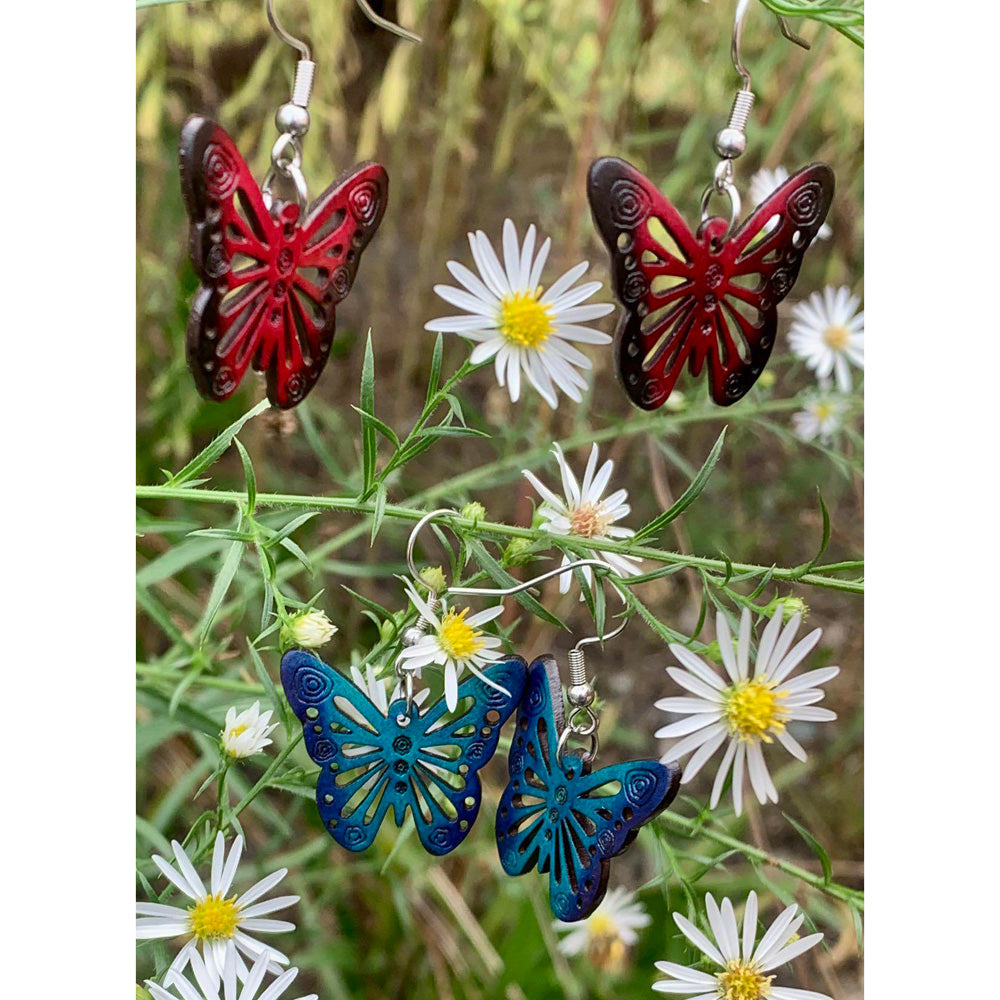OWP
Dangle Butterfly Earrings- Hand-Carved Gourd Earrings-Colombia-Fair Trade
Dangle Butterfly Earrings- Hand-Carved Gourd Earrings-Colombia-Fair Trade
Couldn't load pickup availability
Dangle & Drop Butterfly gourd earrings. Each pair of earrings is laser etched from dried/baked gourds and then hand-painted. Each earring is mounted with a stainless steel shepherd's earring hook and is extremely lightweight. These unique earrings would make a beautiful and unique gift for any occasion!
Available in two colors: Blue and Red
Measurements: 1" x 1" each earring
Handmade in Colombia and Fair Trade imported.
Piel Acida employs more than 12 artisans who work in their factory and approximately 30 more artisans who work from their home permitting women to help support their families while caring for their children. While Piel Acida employs both men and women, the majority of workers are women providing needed income-generating opportunities for women in Colombia. The artisans at Piel Acida participate in the decisions that affect their livelihoods, such as wage determination for the products they create. This involvement is vital as each is paid depending upon the number of pieces they produce in a month.
Click on "About the Artisans" to learn more about the talented artists who make these eco-friendly, vegan-friendly earrings.
Share
About the Artisans
About the Artisans
 Joyeria Semilla meaning Seed Jewelry is a small fair-trade workshop in the Andean town of Villa de Leyva, Colombia. Girasol Taborda, a local artisan and social entrepreneur, started the workshop in the mid-1990s.
Joyeria Semilla meaning Seed Jewelry is a small fair-trade workshop in the Andean town of Villa de Leyva, Colombia. Girasol Taborda, a local artisan and social entrepreneur, started the workshop in the mid-1990s.
Joyeria Semilla’s objective is three-folds; to create new jobs, revive Colombia's handicrafts sector and to motivate locals to better manage their natural resources. The organization works primarily with socially and economically disadvantaged youths, single mothers and people with disabilities in the area. The company offers free training in product design, technical training and marketing to new members. Joyeria Semilla has trained them in the craft of jewelry-making.

Caña Flecha or “Gynerium Sagittatum” is a locally found palm tree in the regions of the Caribbean coast. The leaves from this plant are used for making jewelry, woven hats, bags and baskets. The Zenú Indians were and their descendants inherited the tradition of picking veins of the green palm leaf for weaving. These veins were made into woven hats and other products for their personal use.
The Zenú culture is said to have existed between 200BC to1600AD. With the arrival of the colonizers in the 16th century, the indigenous community declined of unknown reasons. Today a very small population remains that claims the inheritance of the almost extinct Zenú tribe. Known for their skills in the construction of major waterworks, canals and irrigation system along with being skilled goldsmiths, examples of their accomplished craftsmanship are found in various museums around the world. Their larger means of subsistence were hunting, farming, fishing and trading.
Caña Flecha is found in abundance in the region, and hence makes for a sustainable and naturally available raw material for these products. Every bit of the plant is utilized – from using in building walls and roofs in houses to food for cattle and medicinal purposes. It is from the central vein of the leaf that the fibers for weaving are obtained. After the hard surface is peeled off, the fibers are left in the sun to dry and undergo a natural tinting process; these fibers are barely about 1 millimeter in thickness and hence call for a lot of skill and patience to weave with. The dried fibers are then processed for natural coloration - some are boiled with lemon to whiten them and some are treated with mud and boiled with plantain leaves to blacken them. The designs are based on ancient motifs and mathematical representations, which are inspired by the early Zenú culture.






